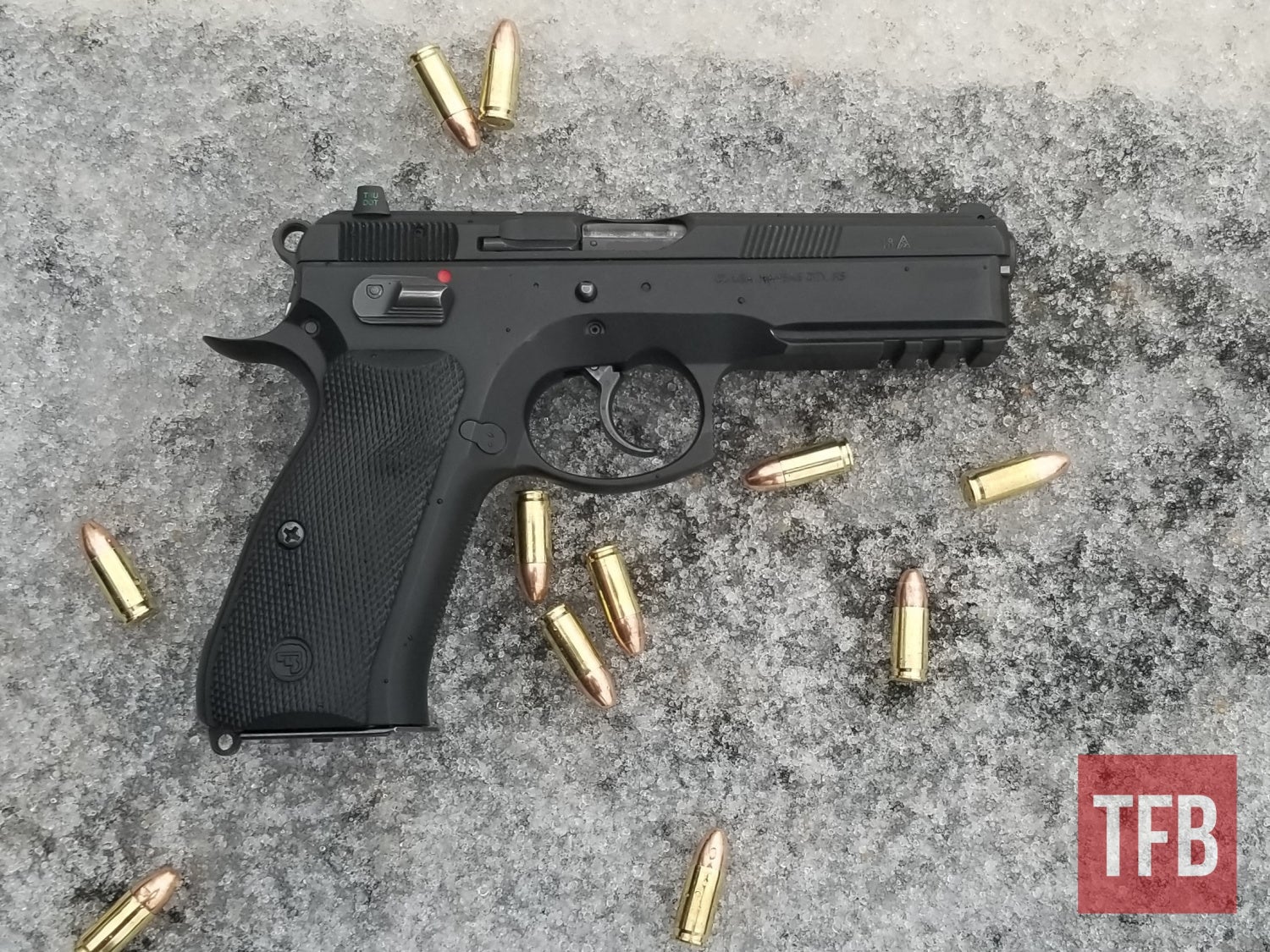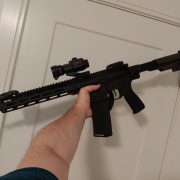So you want to sell a gun on GunBroker. Are you sure? No, really, are you sure? Are you absolutely sure? Personally, I subscribe to the “no sell, only buy” philosophy of gun ownership. But if you want to sell your gun, and actually get it sold for a reasonable price, read on.
Step 1: Value your gun, reasonably
The first step in selling your gun is figuring out how much you can reasonably (please note the emphasis) expect to get for it in the current market. A good rule of thumb to follow, used guns that you bought new will depreciate by about 30-50% as soon as you bring them home. They’re like cars in that way. No, the Taurus 82 revolver you bought for $475 brand new is not worth $475 anymore. Obviously, there are exceptions to this rule, VEPRs, Saigas, milsurp and the like are not going to get cheaper. Generally, though, accept that your gun has depreciated in value.
Go to GunBroker, and at the top right click on “Advanced” next to the search bar.

Follow the red arrow
Once there click on “Completed Items”.

Keep following that arrow
Then search for the gun you are selling. Be as specific or as generic as you feel is warranted. For example, let’s say you want to sell a Mosin-Nagant M91/30. If it’s just a generic round-receiver wartime production Mosin, then you’ll be well served by searching “Mosin”. If however, your gun is an original PU Sniper, then searching “Mosin Sniper” or “Mosin PU Sniper” will get you better results. The same basic steps go for selling any gun.
If there is nothing special about it, then search for the generic model. If it is special in some way that means something to other people, not just to you, then put that in the search bar as well. On the other hand, if you’re selling a military surplus gun that has all matching serial numbers, you should add “all matching” to the search bar. Or, if you’re selling a pre-1994 Colt Sporter, then putting in “pre-ban” will get you better results.
Once you’re there, you’re going to want to switch the sorting to “Bid Count: High to Low”.

The Red Arrow knows all
Start Reading the Results
Skip the first handful of results. Especially ones with more than a reasonable number of bids. People are not always logical when bidding on things, and will get sucked into bidding wars. They convince themselves that they have to have this one specific item, and will pay way more than they would have if they waited a bit and just got the practically identical lot that was ending a few hours later. Don’t count on a bidding war happening with your gun. It might happen, but it also might not, and assuming that you’re going to get above market value is a fast track to disappointment. Continuing the Mosin-Nagant example, the first lot in my search is a fairly nice 1938 round-receiver.

That is a lot of bids, which you should not expect unless your gun is extremely rare.
There is nothing special about this gun, it’s just kinda nice, and it went for an eye-popping $720 ($765 after shipping). It also has 68 bids, which to me indicates a bidding war that you shouldn’t bet on happening with your gun.
Next, mentally filter out guns with unique features your gun doesn’t have. The second lot is a PU Sniper, our pretend gun is a bog-standard wartime production 91/30, not a sniper. Skipped. The third lot is a bog-standard wartime production 91/30, just like ours. It went for $545. Okay, that’s one data point. Continuing on past another sniper model, a Finnish Mosin, a Remington Mosin, another two bidding wars, and we start arriving at lots that resemble ours. Relatively low bid count (in the 10s and 20s and low 30s), wartime production 91/30s.

This looks about right
As you go through the completed lots, you can start to get a sense of what your gun will probably go for. Try to be conservative in your estimates. Sure, you might get lucky and have a bidding war start on your gun, but you probably won’t. Having a realistic price estimate is important. For our imaginary M91/30, it seems like somewhere around $400 is a reasonable estimate.
Take some good pictures
Now that you have a realistic price, and you think it’s one that you’re willing to let your gun go for, it’s time to take some pictures of your gun. Taking good pictures is probably the easiest and best way to make sure you get the most value on GunBroker. Take as an example, this picture of my SA-85M.

This is bad. Don’t do this.
This is a terrible picture. Don’t take pictures like this. It’s dark, it’s cluttered, it was very obviously rotated, and you can’t make out any details of the gun. Optimize your pictures. Imagine if you were buying a gun. Would you rather buy a gun with a picture like that or a picture like this?

This is good, or at least better. Do this.
This still isn’t perfect, you can see some litter in the background and I should probably wipe off my car seat. But it is still far better than the other picture. It also took no effort on my part, at all. I took this picture on the way home from the gun store after buying this, and just put it on the seat next to me for the picture.
I recommend watching James’ excellent video on the subject of taking good gun photos. The short version is to use natural light, be outdoors if possible, make sure it’s in focus, and if possible make the photo interesting. What do I mean by interesting? Compare these two photos.

Bland background

Interesting background
These are the same gun in two photos, that I took on the same day with the same camera. The only difference is the background. One shows off my accumulated wealth of about $500 in 9mm ammo, as well as some ice, the other is completely bland. The second image is more interesting, which means it gets more views, which means people are going to want to bid on it more.
If you’re selling military surplus, or something otherwise rare and interesting, make sure to take clear close-up photos of the markings on your gun.

Note the clear markings, even if the lighting is not the best.
There is nothing more infuriating as a gun buyer than having to ask for a picture of the receiver markings because the lister didn’t add them.
List your gun on GunBroker
The rest of the listing process is incredibly straightforward and incredibly unimportant. No, seriously. The actual listing process has almost nothing to do with how well your gun sells. If you have a realistic estimate of the sale price, and some good photos, you’re probably going to sell your gun for what you expect to get.
I only have a few recommendations for the actual listing. First, don’t be that guy that adds half a dozen guns that yours isn’t to the item title. If someone wants a Mauser 98, then listing our imaginary M91/30 as “Mosin-Nagant M91/30 NOT Mauser Springfield SKS Enfield MAS” is not going to trick them into buying it. It’s just going to mildly irritate them and will almost certainly not sell your gun for any more money.
Second, add all of the descriptors that you can think of to the listing. If the gun has a small crack on the wrist, take a photo of it and add it to the description. Add anything that makes the gun interesting or unique. Consider adding a brief history of the model or gun if you know it. I assure you, people do read the descriptions, and more information is always better.
Third, set the starting bid you’re willing to accept the risk of. Penny auctions, those with a starting bid of $0.01, have a tendency to end slightly above the market price. However, be aware of the possibility that it will sell for less than you’re hoping for. You can add a reserve price, but that will incur a GunBroker fee of 2% of the sale price. It’s your choice as to whether you think that’s worth it, instead of setting the starting bid at the lowest price you’d take. This is also why having realistic expectations is important. We can list our basic wartime production M91/30 for $1000 if we want, but nobody is going to bid on it, so what’s the point?
Fourth and finally, bear in mind that GunBroker is going to charge you a Final Value Fee, the formula for which can be found here. Don’t forget to budget some money for that.
I hope people found this article helpful. As always, please let me know what you think in the comments.


